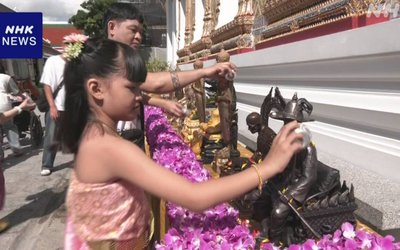
Acclaimed travel writer and author Isabella Tree first visited Nepal from her home in the UK as a teenager. She fell in love with the Kathmandu Valley. She now vividly remembers the wild hippy days of the Freak Street. But she was particularly intrigued by the Living Goddess, a fascination that was to draw her back to Kathmandu again and again over the years. Ultimately her obsession led to her fourth book, 'The Living Goddess', a labour of love that has involved 13 years of research. Initially Isabella conceived the book as a novel - a departure from her previous biography and travel books - but came to realise that she would do better justice to the subject by writing it as non-fiction. Guna Raj Luitel had an email conversation with Isabella about her book and her passion for writing.
How do you feel at this moment when you're waiting for the launch of your book in Nepal?
I'm excited. It's been a long time coming! I can't quite believe that all that time and all those experiences and meetings have now materialized into a physical book. I'm looking forward to thanking all the many people, including present Kumaris, ex-Kumaris and their families, Kumari caretakers, astrologers and tantric priests, and especially my research assistant, the wonderful Mr Kashinath Tamot, who have helped me with my research. It's been an extraordinary journey. But I'm also aware, on a more personal level, that this is just the beginning.
How did you know about Kumari, the Living Goddess? Why have you chosen to write on this subject?
I first came across the Living Goddess when I was 18, travelling in my gap year in 1983 after finishing school, with three friends - one of whom later became my husband. We ended up in Kathmandu renting a couple of rooms at the top of Freak Street overlooking the old royal palace of Hanuman Dhoka. So we found ourselves, quite by accident, as the next-door neighbors of the Living Goddess. I became completely intrigued by her. At night we could see a little figure in red flashing past the windows on the second floor. We used to drop into the courtyard of the Kumari Chen almost every day, hoping to see her at her window.
But it was almost impossible to find out much about her. When I returned to Nepal in 1997 to stay with an English friend who had moved out to Kathmandu I tried to find out more. Eventually I met ex-Kumari Rashmila Shakya, and our meeting formed the basis of an article I wrote for the Sunday Times in the UK.
But it wasn't until 2001, after the royal family massacre, that I decided to write a book about the Kumari. I wanted to understand the connection between the Kumari and the King, how it came to be that the most powerful man in the land, a Hindu, had to kneel before a little Buddhist girl in order to receive permission to rule his country. I was fascinated by how that system translated into the present day and, as political events unfolded and the monarchy was abolished, I wanted to see how the Kumari tradition would ride the political storm, whether she would still have a meaningful role to play in a new Republic. But most of all I wanted to understand what the Kumari meant to the people who worshipped her. And whether the tradition had any message for people like me living outside Nepal.
Was it very difficult to understand the Nepalese context?
Naturally, as a westerner, the idea of worshipping a Goddess - let alone a living human being - is totally alien. We have nothing like this in Christianity or Judaism. We have one God and he is incontrovertibly male. The Virgin Mary - the only prominent female figure in Christianity - is very passive, long-suffering and subservient. In the Church she came to represent how all good women should be. So to me it was thrilling to find a culture where Mother Goddesses were powerful and awe-inspiring, and to see how this feeds into society. I began to look at my own culture in a different light, and to realize how fundamentally patriarchal we are in the west. We've lost touch completely with the concept of the divine feminine - our Mother Goddesses disappeared long ago- and I think that is reflected in our culture.
I know you've been working on this book for many years. Were you ever tempted to give up on this subject ? Or was it always an exciting topic for you?
There were definitely moments when I wondered if I was ever going to be able to complete the book, or perhaps - more importantly - do justice to my subject. I think that's what worried me the most. I hope I've done that. 'The Living Goddess' began as a novel but I soon began to realize that the true story of the Kumari tradition was much more fascinating than fiction, and much more important to write about. That's what kept me going - a burning desire to tell people about her.
I changed from writing fiction to fact because I realized the true story needed to be told. This was partly in response to the rumors and misconceptions about the Kumari tradition and partly because I felt the tradition had something really important to say to the world. So the book needed to be factual and really carefully researched.
What are you trying to portray in this book?
There are a lot of rumors surrounding the Kumari that just aren't true. Like the idea that ex-Kumaris never marry, that anyone who tries to marry an ex-Living Goddess dies in some ghastly, bloody way. Or that ex-Kumaris are abandoned when they leave office, or trafficked to Mumbai or Bangkok as prostitutes, or that they're drugged, starved or abused while they are Kumaris. I still hear people saying these things. So one of my intentions in writing this book was to try and lay these rumors to rest once and for all.
Some people are raising questions against Kumari tradition. Do we really need to care about it?
Yes, it's really important to get the facts straight. As writers and journalists we have a responsibility to be meticulously thorough and honest in our research. Even if, as it often does, this involves a lot more time and effort, intellectual rigor and self-questioning. A lot of the rumors and misconceptions about Kumari have been perpetuated through sloppy reporting. Ex-Kumari Rashmila Shakya is very eloquent about this in her excellent autobiography 'From Goddess to Mortal'. She has been misrepresented so many times in the press by journalists bent on sensationalism.
I think there's also a problem here, too, about preconceptions. As outsiders to the tradition we see a little girl incarcerated in a house, living away from her parents, unable to go out except on rare occasions, and we leap to the supposition of child abuse. We instinctively feel protective towards her. Human rights activists have become particularly vocal over the last few decades claiming that she is abused and mistreated, that she represents a tradition that is degrading to women and children. But when you look closely and scrutinize what actually happens and why it happens, you discover that really it's the exact opposite. The Kumari is a beacon for the empowerment and protection of women and children. She is a reminder to everyone that true power resides beyond the material, political world; and that female creative energy, the spark of life that resides within every woman and girl, is something to be revered and cherished. This is something I think all of us need to be reminded of. You only have to look at the global abuse of children and violence against women to realize that something is severely out of kilter.
I often think how amazing it would be if the Prime Minister of the UK had to bow before a little girl every year in order to receive permission to head the government! In fact, if everyone in authority, mothers, fathers, teachers, soldiers, politicians, bankers, doctors, immigration officials, regularly knelt at the feet of little girls - imagine how that would change the world!
Will this book be liked by the readers around the world? Why should they read this?
I do hope the book will have broad interest. I feel the practice of Kumari worship has so much to offer us, especially the kind of universal loving kindness it generates in those who worship her.
It's a Nepalese story published in English. Do you think it should be published in the Nepalese language too ?
I would love it to be translated into Nepali - and Newari! I hope there's a lot that Nepali readers will find interesting in it. With the help of Kashinath Tamot, I uncovered a lot of new and exciting material about the origins of the Kumari tradition - it's far, far older than most people realize - and I've woven some of the traditional myths into the book that will be familiar to a lot of Nepali readers. The story of Shiva and Sati from the Swasthani Vrata Katha is my favorite. I love the way the Nepali spin on the story reveals Sati as the all-powerful terrific Mother Goddess and has Shiva quaking with fear in front of her.
What attracts you in writing?
I've always loved writing, for as long as I can remember. I used to write plays when I was a child with myself as the heroine, and the boy I fancied as my knight in shining armor, and my younger sister was usually the slave. I thought writing was what everyone naturally wanted to do. I just can't imagine not doing it. But I also cherish the ability to be able to communicate what one really wants to say. I often feel I don't know what I really think about something until I sit down to write about it. It's that considered, deep process that makes writing worthwhile.
What changes have you noticed in Nepal over the years since your first visit?
The physical changes in the Kathmandu Valley have obviously been very dramatic. In the 1980s, we used to bicycle through rice fields to Bouddha. There were avenues of trees, no ring-road cutting off the city from the rest of the Valley, little pollution. You could walk to places like Swayambhu quite easily without being afraid of being mown down by motorbikes and trucks. The rivers were not nearly so toxic, and many more fresh water wells and fountains were working. It's heartbreaking to see the environmental impact that unregulated urban growth has had - is having - on this beautiful Valley. I think that's the main reason tourists often don't linger here - they take one look at the busy capital and head straight out on trek, or fly to Bhutan. But there are still so many beautiful things to see in the Kathmandu Valley and the restoration work that has gone on in the Durbar Squares of Kathmandu, Patan and Bhaktapur over recent years has been astounding. The Kathmandu Valley Preservation Trust is doing amazing work and many of the pagoda temples that were falling into ruin when I was a teenager have risen from the ashes. To my mind these are some of the most beautiful urban spaces in the world.
As a writer what difference you've found between your third book Sliced Iguana and Living Goddess?
My previous book, like my second book, was more of a travel book. I was recounting my impressions as I travelled amongst the indigenous peoples of Mexico, and before that, amongst the tribes of Papua New Guinea. 'The Living Goddess' is a journey, in a sense, too - but instead of travelling distances and encountering many different cultures it's felt like a journey that's taken me deeper. Deeper, in fact, than I ever imagined. It's certainly changed the way I look at the world, and my own culture. I think the effects of writing about Kumari will continue affecting me for the rest of my life.
- NEPAL-THAILAND: Joint Business Council
- Apr 13, 2025
- BIMSTEC SUMMIT: Nepal’s Stand
- Apr 11, 2025
- IME GROUP: Expands Into Paper Industry
- Mar 24, 2025
- CPN UML: Instigated By India
- Mar 23, 2025
- ADB’S CHIEF ECONOMIST: Nepal Reduces Poverty
- Mar 11, 2025















